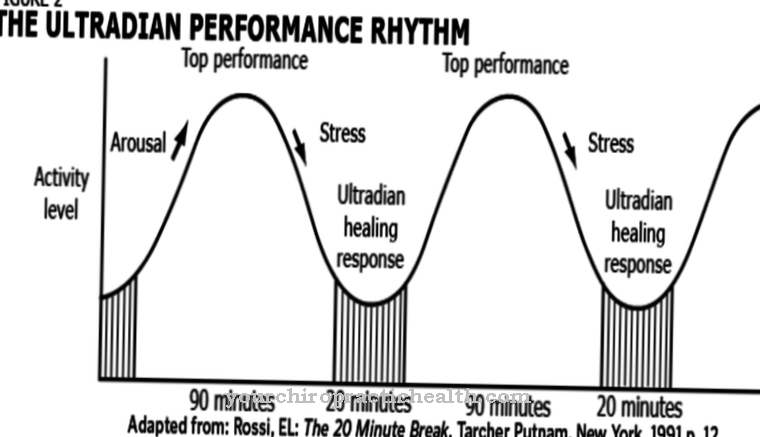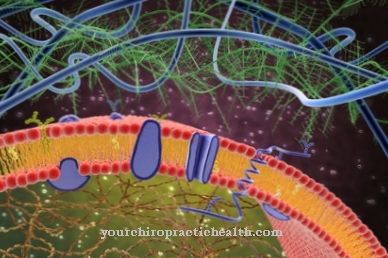Human memory can be divided into different types. The Short term memory, which is of great importance to humans, is a type of it and is different from long-term memory. Short-term memory plays an important role, especially in people's everyday lives.
What is short term memory?

The human memory is characterized by a multi-memory model. Three memories are provided: the ultra-short-term memory, the short-term memory and the long-term memory. The term short-term memory comes from psychology. Short-term memory is located in parts of the frontal and parietal lobes of the human brain.
If information is received via sensory organs, it first reaches the ultra-short-term memory, also known as sensory memory. The relevant information is passed on to the short-term memory, irrelevant information is forgotten.
In short-term memory, also known as working memory, information is stored for a short time and processed consciously. The content is temporarily available and will be forgotten after a short time. This distinguishes short-term memory from long-term memory, in which content is permanently stored in the memory. Short-term memory is the ability to store information in the memory for a short period of time without stressing the actual memory.
Function & task
In short-term memory, things, information and facts stay in the memory from a few seconds to a minute, or the first distraction. The available information can be cognitively processed, reflected and changed in working memory. This is necessary, for example, to understand the content of sentences.
Information processing in short-term memory is around seven sensory / information units per minute. So seven numbers can be kept in a row. If there are more than ten numbers in a row, only fragments are saved. Repetitions are used to store information for longer. Linguistic information is better absorbed and stored more easily than other types of information.
The functions of short-term memory are used permanently. Without this type of memory, events and experiences that were made immediately cannot be stored. Distraction erases information from memory and replaces it with new, more relevant information when working memory capacity is exceeded.
The main function of short-term memory is the intermediate storage of information, things and content. It is now assumed that short-term memory is a multi-memory model in which different subsystems are responsible for different types of information.
Short-term memory plays a central role in people's everyday actions. It is constantly needed in school, work and private life. It also serves as the basis for further neuropsychological performance, concentration and attention. According to brain research, short-term memory serves as an indicator of human intelligence.
You can find your medication here
➔ Medicines against memory disorders and forgetfulnessIllnesses & ailments
Forgetting is an important part of human memory. Irrelevant information is deleted and space is made for something new. However, especially in old age, there may be fluctuations in memory and memory loss. These often affect short-term memory. In addition to mental losses, neural disorders and diseases can occur.
Memory disorders are one of the most common consequences of damage to the brain. They are known as amnesias. Short-term memory is impaired in anterograde amnesia. The acquisition of new knowledge is limited and information after the brain damage event cannot be adequately accessed. Amnesias often occur after a traumatic brain injury.
Amnesia can also result from migraines and meningitis and thus limit short-term memory. Dementia is another form of memory disorder.Dementia is caused by a circulatory disorder in the brain and is a progressive, usually irreversible, organically caused loss of previously acquired intellectual abilities while maintaining consciousness.
The most common form of dementia is Alzheimer's disease or Alzheimer's dementia. This denotes a creeping decline in short-term memory, spatial-temporal orientation and a decline in everyday skills. In the course of time, there are ever greater limitations in memory and the performance of everyday tasks, social withdrawal and language disorders.
The late stage of Alzheimer's dementia is characterized by massive memory disorders. Your own apartment and family members are no longer recognized. Behavioral disorders and a complete loss of everyday skills are combined.
Short-term memory can also be impaired in other neurological diseases such as epilepsy. Epilepsy is a chronic disease that results in epileptic seizures. The attacks are usually accompanied by convulsions. The consequences are impaired consciousness and memory lapses. In the case of epilepsy, in contrast to the incurable disease of Alzheimer's disease, drugs help to prevent seizures and memory disorders.
Short-term memory disorders also occur as side effects of strokes, Creutzfeldt-Jakob disease or Parkinson's disease. Psychological disorders such as depression or anxiety disorders can also affect short-term memory. Head injuries and brain tumors also affect working memory. In children, forgetfulness is often a sign of severe attention disorder (ADHD).
Studies have shown that the function of temporary storage in short-term memory can be improved. While brain training is hardly successful in some neurological diseases, disorders of the short-term memory caused by stress or other causes can be remedied and performance can be improved through training.
There are a variety of helpful exercises for memory training. With the training of working memory, learning and thinking skills, attention, concentration, reaction skills, cognitive flexibility, spatial imagination, as well as language and arithmetic skills are trained at the same time.
Short-term memory disorders are experienced by those affected as stressful and traumatic, as they affect everyday life and almost all relevant actions in a person's life.



























